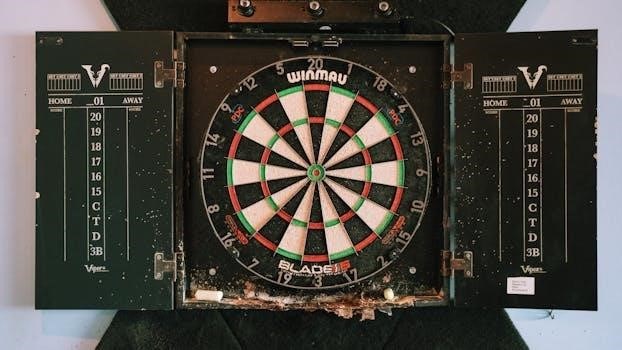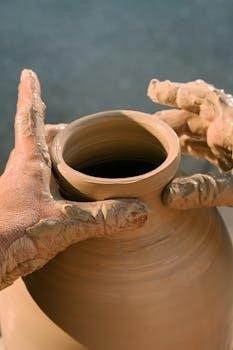
Manual Scoreboards⁚ An Overview
Manual scoreboards are traditional scoring devices used in sports to display scores․ They offer a cost-effective solution and are flexible for various recreational scenes in schools and clubs․ Often, they are an alternative to electronic counterparts․
Definition and Purpose of Manual Scoreboards
Manual scoreboards are traditional display boards used to keep track of scores in sports and games․ Operated by hand, they involve physically updating the displayed numbers or information․ Their primary purpose is to provide real-time score updates to players and spectators․ Additionally, they are essential for maintaining transparency and fairness during sporting events․ They serve as a visual reference for everyone involved, ensuring that the current game status is clearly communicated․ They can also show team names, rosters, and sponsors․
Common Sports Using Manual Scoreboards
Manual scoreboards are versatile and utilized across numerous sports at varying levels of competition․ Common sports include baseball, where they track innings and runs, and basketball, for displaying points․ They are also prevalent in sports like volleyball, tennis, and even cricket․ These boards provide essential real-time updates for participants and spectators․ Rugby, hockey, and soccer frequently employ manual scoreboards, especially in schools and local clubs․ Their simplicity and reliability make them suitable for many settings where electronic scoreboards aren’t feasible or necessary․

Types of Manual Scoreboards
Manual scoreboards come in various designs to suit different sports and settings․ These range from multi-sport boards to those specifically designed for cricket, rugby, hockey, and soccer, offering tailored functionality․
Multi-Sport Manual Scoreboards
Multi-sport manual scoreboards are designed to accommodate various sports, offering versatility for schools and clubs․ These scoreboards often feature changeable panels or sections to display scores and information relevant to different games․ They are a cost-effective solution for institutions with diverse athletic programs, providing a single scoreboard that can be adapted for multiple sports, eliminating the need for sport-specific boards․ They are a flexible and adaptable solution for various sporting events, be it indoor or outdoor!
Sport-Specific Manual Scoreboards (Cricket, Rugby, Hockey, Soccer)
Sport-specific manual scoreboards are tailored for individual sports like cricket, rugby, hockey, and soccer, with features designed around the game’s unique scoring systems․ These scoreboards often include sections for innings, runs, wickets (cricket), or periods and penalties (hockey, soccer)․ Their design reflects the specific requirements of each sport, ensuring accurate and easy-to-understand scoring information for players and spectators․ They are a great way to keep track of the score and add to the overall atmosphere of the game․
Features and Benefits
Manual scoreboards offer cost-effectiveness, portability, and weather resistance․ They are easy to use, durable, and can display team names and sponsor information․ They provide a flexible scoring solution for schools, clubs, and recreational settings․
Cost-Effectiveness
Manual scoreboards present a budget-friendly alternative to electronic displays․ Their initial purchase price is significantly lower․ They don’t require electricity, reducing operational costs․ Maintenance is minimal, avoiding expensive repairs and specialized technicians․ For schools and clubs with limited budgets, manual scoreboards offer a practical solution for effective sports scoring․ They enable organizations to allocate funds to other essential areas while still providing a functional scoring system․ This makes sports accessible even with financial constraints․
Portability and Weather Resistance
Many manual scoreboards are designed for easy transport․ They are suitable for various locations, both indoors and outdoors․ They can be moved around a sports complex or taken to different venues․ The weather-resistant construction protects them from the elements․ They can withstand sleet, rain, and snow, ensuring reliable use in diverse conditions․ This durability makes them ideal for locations where weather is unpredictable or facilities lack covered scorekeeping areas․ Portability and weather resistance contribute to their versatility․
Evolution of Scoreboards
Scoreboards have dramatically improved, especially in displaying information․ Newer technologies have enabled the updates, making them more user-friendly for schools․ From manual systems to digital displays, scoreboards continue to evolve with the modern game․
From Manual to Electronic Scoreboards
Early scoreboards were operated manually, where individuals physically changed numbers; However, technological advancements led to electronic scoreboards with LED technology․ These electronic versions offer cost efficiency and ease of use, displaying digital content like videos and animations․ The transition marks a significant shift in sports, enhancing fan engagement and providing more dynamic displays of scores and related information․ Though manual boards are still in use, the trend leans towards electronic systems․
Impact of LED Technology on Scoreboards
LED technology has revolutionized scoreboards, offering enhanced visibility and versatility․ LED scoreboards display graphics, animations, and video content, improving fan engagement compared to manual scoreboards․ Their cost efficiency and ease of use have led to widespread adoption in sports venues․ LED displays also allow for dynamic content like advertisements and replays, creating a multimedia experience․ While manual scoreboards remain viable, LED technology has significantly elevated the standard for sports scorekeeping and presentation, offering a superior visual experience․
Manual Scoreboards in Modern Sports
Despite technological advancements, manual scoreboards are still used in modern sports, especially in schools and clubs․ They offer a cost-effective method for sports scoring where electronic units aren’t feasible or necessary․
Use in Schools and Clubs
Manual scoreboards find significant application within schools and clubs due to their affordability and straightforward operation․ They serve as an accessible means of tracking scores for various sports, enabling students and club members to engage actively in games․ These scoreboards provide a practical solution for organizations with budget constraints, offering a reliable way to display scores without requiring complex technological infrastructure․ Their ease of use makes them suitable for volunteers or staff with limited technical expertise․ They promote engagement and understanding of the game․
Notable Examples (e․g․, Fenway Park)
Fenway Park, home of the Boston Red Sox, showcases a prominent example of a manual scoreboard․ Despite having an electronic scoreboard, fans often refer to the manual scoreboard at the base of the Green Monster․ This classic feature adds to the park’s charm and provides updates from other games around the league․ It highlights the enduring appeal of traditional scorekeeping methods․ It serves as a nostalgic reminder of baseball’s history․ It is a testament to its lasting impact on sports culture․

Operation and Maintenance
Manual scoreboards are simple and quick to install and operate․ Their use is intuitive․ They generally are durable․ Manual scoreboards are a reliable option for schools and clubs․ They don’t require electricity․
Installation and Ease of Use
Manual scoreboards stand out for their straightforward installation, making them a practical choice for various sporting venues․ Unlike their electronic counterparts, these scoreboards generally do not require complex wiring or technical expertise for setup․ Operation is equally simple․ The scoreboards usually rely on manual flipping of numbers or cards․ This allows for immediate and intuitive score updates, even without specialized training․ This ease of use makes them ideal for schools, clubs, and recreational facilities where simplicity and reliability are prioritized․
Durability and Longevity
Manual scoreboards are known for their robust construction, contributing to their exceptional durability and extended lifespan․ Constructed from sturdy materials, these scoreboards can withstand the rigors of frequent use and exposure to various weather conditions․ With fewer electronic components compared to digital scoreboards, the risk of malfunction is significantly reduced․ This inherent simplicity translates to less frequent maintenance and fewer repairs, ensuring that manual scoreboards can reliably serve sporting events for many years, delivering a dependable and long-lasting scoring solution․

Customization and Options
Manual scoreboards offer customization, with space for team names and sponsors․ Scoreboards frequently arrive pre-assembled and are easy to install․ Various scoreboards offer space for team names, rosters, and sponsors to customize your board․
Team Names and Sponsor Space
Manual scoreboards frequently offer customizable sections specifically designed for displaying team names, allowing for clear identification during games․ These boards also often include dedicated spaces for sponsors, providing valuable advertising opportunities and financial support for sports programs․ The integration of sponsor logos and names enhances the visual appeal of the scoreboard․ This increases visibility for supporting businesses while adding a professional touch to the sporting event․ This blend of team identification and sponsor recognition makes manual scoreboards a versatile tool for both athletic display and marketing purposes․ Scoreboards arrive pre-assembled and are easy to use․
Sizes and Dimensions
Manual scoreboards come in a variety of sizes and dimensions to accommodate different sports and venue requirements․ Smaller, portable models are ideal for youth leagues and smaller fields, offering easy transport and setup․ Larger, more permanent scoreboards are suitable for stadiums and high school fields, ensuring visibility from a distance․ The dimensions often depend on the number of digits needed to display scores, innings, and other relevant game information․ Choosing the right size ensures optimal readability and integration with the surrounding environment․ Ultimately, the choice depends on the sport and the location’s specific needs․

Alternatives to Manual Scoreboards
While manual scoreboards offer simplicity, electronic and portable scoreboards present alternatives․ Electronic options enhance fan engagement with dynamic displays․ Portable versions provide flexibility for various sports and locations, such as temporary events;
Electronic Scoreboards
Electronic scoreboards represent a significant advancement over manual versions․ LED technology allows for dynamic displays, presenting graphics, animations, and video content, enhancing fan engagement․ They offer real-time updates and integrate features like timers and statistics․ These scoreboards are cost-efficient, easy to use, and offer a broad range of digital content․ They are suitable for schools and sports clubs․ Installation and operation are also relatively simple․
Portable Scoreboards
Portable scoreboards, often manual, offer flexibility for various sporting events, both indoors and outdoors․ These scoreboards are essential for displaying real-time scores, typically allowing scoring up to 99 points per team․ Many are weatherproof, suitable for use in different weather conditions․ They are easy to transport and set up, making them ideal for temporary venues․ Some models even include space for team names and sponsor logos․ They often arrive pre-assembled, ready for immediate use․